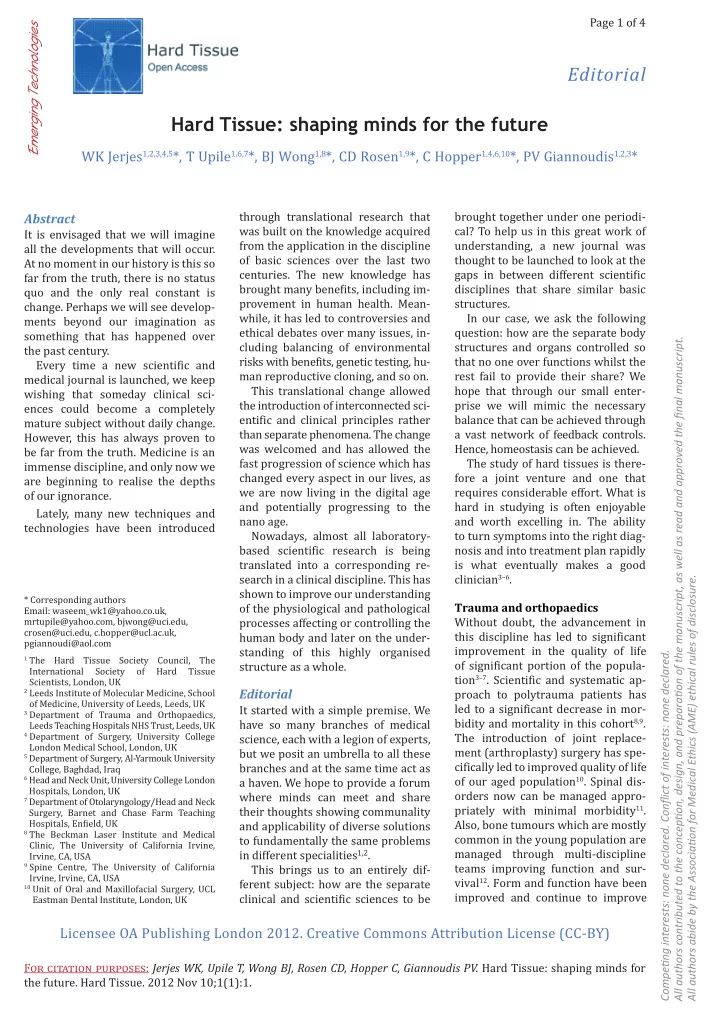

Emerging Technologies Page 1 of 4 Editorial Hard Tissue: shaping minds for the future WK Jerjes 1,2,3,4,5 *, T Upile 1,6,7 *, BJ Wong 1,8 *, CD Rosen 1,9 *, C Hopper 1,4,6,10 *, PV Giannoudis 1,2,3 * Abstract through translational research that brought together under one periodi- was built on the knowledge acquired cal? To help us in this great work of It is envisaged that we will imagine from the application in the discipline understanding, a new journal was all the developments that will occur. of basic sciences over the last two thought to be launched to look at the At no moment in our history is this so centuries. The new knowledge has gaps in between different scientific far from the truth, there is no status brought many benefits, including im- disciplines that share similar basic quo and the only real constant is provement in human health. Mean- structures. change. Perhaps we will see develop- while, it has led to controversies and In our case, we ask the following ments beyond our imagination as ethical debates over many issues, in- question: how are the separate body something that has happened over All authors contributed to the conceptjon, design, and preparatjon of the manuscript, as well as read and approved the fjnal manuscript. cluding balancing of environmental structures and organs controlled so the past century. risks with benefits, genetic testing, hu- that no one over functions whilst the Every time a new scientific and man reproductive cloning, and so on. rest fail to provide their share? We medical journal is launched, we keep This translational change allowed hope that through our small enter- wishing that someday clinical sci- the introduction of interconnected sci- prise we will mimic the necessary ences could become a completely entific and clinical principles rather balance that can be achieved through mature subject without daily change. than separate phenomena. The change a vast network of feedback controls. However, this has always proven to was welcomed and has allowed the Hence, homeostasis can be achieved. be far from the truth. Medicine is an fast progression of science which has The study of hard tissues is there- immense discipline, and only now we changed every aspect in our lives, as fore a joint venture and one that are beginning to realise the depths we are now living in the digital age requires considerable effort. What is of our ignorance. and potentially progressing to the hard in studying is often enjoyable Lately, many new techniques and nano age. and worth excelling in. The ability technologies have been introduced Nowadays, almost all laboratory- to turn symptoms into the right diag- based scientific research is being nosis and into treatment plan rapidly translated into a corresponding re- is what eventually makes a good search in a clinical discipline. This has clinician 3–6 . All authors abide by the Associatjon for Medical Ethics (AME) ethical rules of disclosure. shown to improve our understanding * Corresponding authors Trauma and orthopaedics of the physiological and pathological Email: waseem_wk1@yahoo.co.uk, Without doubt, the advancement in mrtupile@yahoo.com, bjwong@uci.edu, pro cesses affecting or controlling the crosen@uci.edu, c.hopper@ucl.ac.uk, this discipline has led to significant human body and later on the under- pgiannoudi@aol.com improvement in the quality of life standing of this highly organised Competjng interests: none declared. Confmict of interests: none declared. 1 The Hard Tissue Society Council, The of significant portion of the popula- structure as a whole. International Society of Hard Tissue tion 3–7 . Scientific and systematic ap- Scientists, London, UK Editorial 2 Leeds Institute of Molecular Medicine, School proach to polytrauma patients has of Medicine, University of Leeds, Leeds, UK led to a significant decrease in mor- It started with a simple premise. We 3 Department of Trauma and Orthopaedics, bidity and mortality in this cohort 8,9 . have so many branches of medical Leeds Teaching Hospitals NHS Trust, Leeds, UK 4 Department of Surgery, University College The introduction of joint replace- science, each with a legion of experts, London Medical School, London, UK ment (arthroplasty) surgery has spe- but we posit an umbrella to all these 5 Department of Surgery, Al-Yarmouk University cifically led to improved quality of life branches and at the same time act as College, Baghdad, Iraq 6 Head and Neck Unit, University College London of our aged population 10 . Spinal dis- a haven. We hope to provide a forum Hospitals, London, UK orders now can be managed appro- where minds can meet and share 7 Department of Otolaryngology/Head and Neck priately with minimal morbidity 11 . their thoughts showing communality Surgery, Barnet and Chase Farm Teaching Hospitals, Enfield, UK Also, bone tumours which are mostly and applicability of diverse solutions 8 The Beckman Laser Institute and Medical common in the young population are to fundamentally the same problems Clinic, The University of California Irvine, in different specialities 1,2 . managed through multi-discipline Irvine, CA, USA 9 Spine Centre, The University of California teams improving function and sur- This brings us to an entirely dif- Irvine, Irvine, CA, USA vival 12 . Form and function have been ferent subject: how are the separate 10 Unit of Oral and Maxillofacial Surgery, UCL improved and continue to improve clinical and scientific sciences to be Eastman Dental Institute, London, UK Licensee OA Publishing London 2012. Creative Commons Attribution License (CC-BY) For citation purposes: Jerjes WK, Upile T, Wong BJ, Rosen CD, Hopper C, Giannoudis PV. Hard Tissue: shaping minds for the future. Hard Tissue. 2012 Nov 10;1(1):1.
Recommend
More recommend